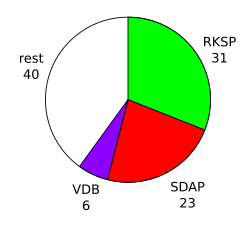Schermerhorn–Drees_cabinet
Schermerhorn–Drees cabinet
Dutch cabinet (1945–1946)
The Schermerhorn–Drees cabinet was the executive branch of the Dutch Government from 25 June 1945 until 3 July 1946. The cabinet was formed by the christian-democratic Roman Catholic State Party (RKSP), the social-democratic Social Democratic Workers' Party (SDAP) and the social-liberal Free-thinking Democratic League (VDB) by royal decree following the end of World War II. The cabinet was a provisional centre-left[2] grand coalition and had a substantial majority in the House of Representatives, with prominent civil engineer Willem Schermerhorn of the Free-thinking Democratic League serving as Prime Minister. Social Democratic Leader Willem Drees served as Deputy Prime Minister and Minister of Social Affairs.
This, the first Dutch cabinet after World War II, was appointed by Queen Wilhelmina just a month after the Netherlands were liberated by the Allied forces. It was a royal cabinet (which means that the cabinet is appointed by the monarch, and is not the result of an election). The States-General of the Netherlands was not yet functional, and would not become so until November 1945.
The cabinet served during the early days of the post-World War II 1940s. Domestically, it initiated recovery and rebuilding, and implemented several major reforms to social security. Internationally, the formation of the United Nations was started and the beginning of the decolonization of the Dutch East Indies.[3][4]
The Schermerhorn–Drees cabinet consisted of ministers from the SDAP (which in 1946 merged with the VDB and the CDU to become the post-War PvdA or Labour Party), the CHU minister Dr. Piet Lieftinck (who became a member of the PvdA on 9 February 1946), the ARP and the RKSP (named the KVP on 22 December 1945). Prime Minister Willem Schermerhorn was a member of the VDB, but would later become a member of the PvdA. Deputy Prime Minister Willem Drees was a member of the SDAP.

